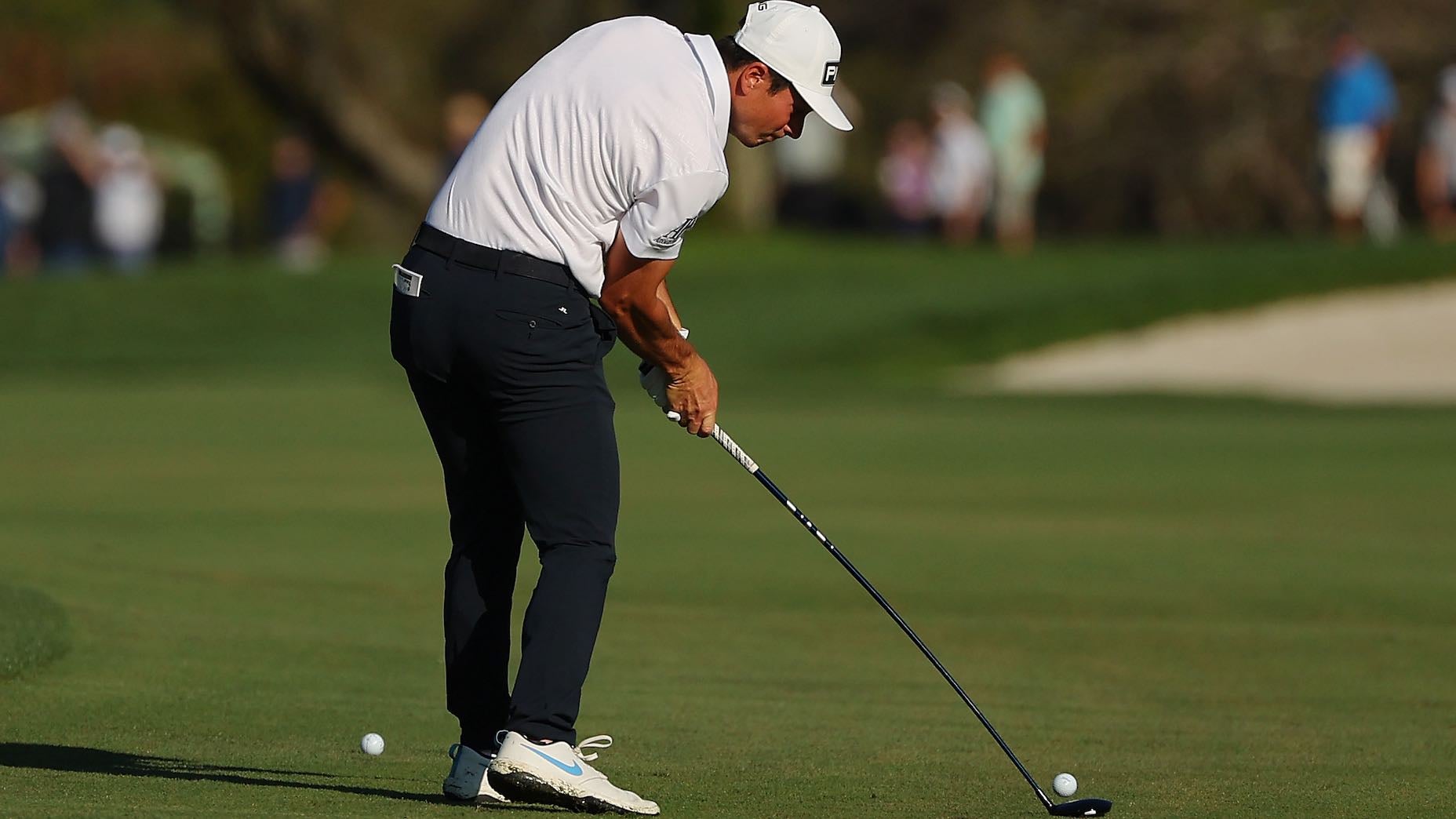To compress a golf ball, strike it with a descending blow using a lofted club. Ensure proper weight transfer during the swing.
Compressing a golf ball properly is crucial for maximizing distance and control. Golfers often overlook the importance of compression in achieving optimal ball flight. By striking the ball with a descending blow and transferring your weight correctly, you can create the necessary compression.
This technique helps generate more backspin, improving accuracy and distance. Practice and proper form are essential to master this skill. Understanding the mechanics behind ball compression can significantly enhance your overall game. Mastering this technique can lead to lower scores and a more enjoyable golfing experience.
Introduction To Golf Ball Compression
Understanding golf ball compression can greatly improve your game. It’s a crucial aspect for golfers of all levels.
What Is Golf Ball Compression?
Golf ball compression measures how much the ball deforms when hit. It is measured on a scale from 0 to 200. A lower number means the ball compresses more.
This deformation affects the ball’s speed and distance. Soft balls compress more and are easier to control. Hard balls compress less and travel farther.
Importance Of Compression
The importance of compression depends on your swing speed. Players with a slow swing speed benefit from low-compression balls. These balls help you gain more distance.
Players with a fast swing speed benefit from high-compression balls. These balls provide better control and accuracy.
Choosing the right compression can enhance your performance. It ensures you get the best results from each shot.
| Swing Speed | Recommended Compression |
|---|---|
| Slow (Below 85 mph) | Low Compression (60-70) |
| Moderate (85-100 mph) | Mid Compression (80-90) |
| Fast (Above 100 mph) | High Compression (100+) |
Use this guide to find the right ball for your swing speed. This helps you achieve optimal performance on the course.
Factors Affecting Compression
Understanding the factors that affect golf ball compression is key. Compression impacts how the ball reacts to your swing. Let’s dive into the main elements that influence this important characteristic.
Core Material
The core material of a golf ball plays a significant role in compression. The core is usually made from rubber or a similar synthetic compound. This material determines how much the ball can compress upon impact.
- Rubber cores: Provide higher compression and more distance.
- Synthetic cores: Offer lower compression for softer feel and control.
Cover Material
The cover material also impacts compression. Golf ball covers are typically made from urethane or surlyn.
| Material | Compression | Characteristics |
|---|---|---|
| Urethane | Higher | Soft feel, good spin control |
| Surlyn | Lower | Durable, less spin |
Manufacturing Process
The manufacturing process can significantly impact the ball’s compression. Different methods are used to produce various types of golf balls.
- Two-piece balls: Simpler design, generally higher compression.
- Three-piece balls: More complex, often offer lower compression.
Understanding these factors can help you choose the best golf ball. You’ll improve your game by selecting the right one.
Types Of Golf Ball Compression
Understanding golf ball compression helps improve your game. Compression affects distance, control, and feel. Learn about different types to choose the right ball.
Low Compression
Low compression golf balls have a rating below 70. These balls are softer and compress easily. They are ideal for beginners and players with slower swing speeds. They offer more distance and a softer feel.
- Rating: Below 70
- Best for beginners
- Soft feel
Mid Compression
Mid compression golf balls have a rating between 70 and 90. These balls balance distance and control. Suitable for average players with moderate swing speeds. They provide a good mix of feel and performance.
- Rating: 70-90
- Best for average players
- Balanced performance
High Compression
High compression golf balls have a rating above 90. These balls are harder and require a faster swing speed. They offer more control and are suitable for advanced players. They provide a firm feel and better accuracy.
- Rating: Above 90
- Best for advanced players
- Firm feel

Credit: www.adamyounggolf.com
Choosing The Right Compression
Choosing the right compression is crucial for optimizing your golf game. It can affect your distance, control, and overall performance. Understanding what factors influence ball compression can help you make an informed decision.
Player’s Swing Speed
Your swing speed plays a significant role in choosing the right compression. Golf balls are often categorized as low, medium, or high compression. Low compression balls are ideal for players with slower swing speeds. They offer more distance and a softer feel. Medium compression balls suit those with moderate swing speeds, providing a balanced performance. High compression balls are designed for players with fast swing speeds, offering better control and less spin.
| Compression Type | Swing Speed | Benefits |
|---|---|---|
| Low Compression | Below 85 mph | More distance, softer feel |
| Medium Compression | 85-100 mph | Balanced performance |
| High Compression | Above 100 mph | Better control, less spin |
Weather Conditions
Weather conditions can also influence your choice of ball compression. In cold weather, balls tend to become harder and lose compression. Opt for a lower compression ball in colder conditions to maintain distance and feel. In hot weather, balls become softer, so a higher compression ball might be more suitable to maintain control.
Personal Preference
Your personal preference is another key factor. Some players prefer a softer feel, while others like a firmer touch. If you enjoy the feel of a soft ball, choose a low compression ball. If you prefer a firmer feel, go for a higher compression ball. It’s essential to test different types to see what works best for you.
In summary, the right compression can enhance your golf game. Consider your swing speed, weather conditions, and personal preference. This will help you find the perfect ball for your needs.
Testing Golf Ball Compression
Understanding golf ball compression can improve your game. It helps you choose the right ball. Let’s explore how to test golf ball compression.
Compression Rating
Compression rating indicates how much a golf ball deforms. Lower ratings mean softer balls. Higher ratings mean harder balls. A lower compression ball suits slow swings. A higher compression ball suits fast swings.
Compression is measured on a scale from 0 to 200. A golf ball with a 0 rating is very soft. A golf ball with a 200 rating is very hard. Most golf balls have a rating between 60 and 110. Here’s a table to help understand:
| Compression Rating | Type | Best For |
|---|---|---|
| 0 – 60 | Low | Slow Swing Speeds |
| 61 – 90 | Medium | Average Swing Speeds |
| 91 – 110 | High | Fast Swing Speeds |
Compression Testing Methods
There are different compression testing methods. These methods measure how much a ball compresses under pressure. Here are the common methods:
- Compression Tester: This device measures how much a ball deforms. The ball is placed under a fixed weight. The tester shows a compression rating.
- Golf Ball Gauge: This tool measures the diameter of the ball. By comparing the diameter under pressure, compression can be inferred.
- Hand Test: This is a simple, manual method. Squeeze the ball with your hand. A softer ball will deform more. This method is less accurate but quick.
Testing golf ball compression helps you find the right ball. This can improve your game. Knowing your swing speed is key. Use the right testing method to get accurate results.

Credit: www.adamyounggolf.com
Improving Distance With Compression
Maximizing your golf ball’s compression can greatly enhance your distance. Compression refers to how much a golf ball deforms under force. Correctly compressing a golf ball means better energy transfer from your swing. This section will explore how you can improve distance with compression.
Optimizing Swing Mechanics
Optimizing swing mechanics is crucial for achieving the right compression. A well-timed swing ensures better energy transfer. Focus on these key aspects:
- Grip: Hold the club firmly but not too tight.
- Stance: Keep your feet shoulder-width apart.
- Backswing: Rotate your shoulders fully while keeping your arms relaxed.
- Downswing: Accelerate smoothly and strike the ball at the lowest point of the swing arc.
Selecting The Right Ball
Choosing the right golf ball can also impact compression. Different balls have varying compression ratings.
| Compression Rating | Ball Type | Suitability |
|---|---|---|
| Low (70-80) | Soft | Best for slow swings |
| Medium (80-90) | Balanced | Good for average swings |
| High (90-100) | Hard | Ideal for fast swings |
For beginners, a low compression ball is ideal. Advanced players can benefit from medium to high compression balls. Selecting the right ball ensures maximum distance and control.
Common Myths About Compression
Golf ball compression is a hot topic among golfers. There are many myths about it. These myths can lead to confusion. Let’s debunk some common myths about compression.
Myth Vs. Reality
Myth: A harder golf ball goes farther.
Reality: This is not always true. Ball distance depends on swing speed. A softer ball might go farther with a slower swing.
Myth: All golfers should use the same compression.
Reality: Golfers have different swing speeds. Each golfer needs a ball that matches their speed.
Myth: High compression balls are only for pros.
Reality: Some amateurs benefit from high compression balls. It depends on their swing speed.
Scientific Evidence
Scientists have studied golf ball compression. Here are some findings:
- Low compression balls compress more with slower swings.
- High compression balls work better with fast swings.
- Compression affects the ball’s spin and control.
Here’s a table to show the ideal compression for different swing speeds:
| Swing Speed (mph) | Ideal Compression |
|---|---|
| 70-85 | Low (60-70) |
| 85-100 | Medium (70-90) |
| 100+ | High (90+) |
Understanding compression helps you pick the right ball. This leads to better performance on the course.
Expert Tips And Recommendations
Compressing a golf ball can improve your game significantly. It’s important to use the right techniques and tools. Here, we provide expert tips and recommendations to help you compress a golf ball effectively.
Professional Advice
Experts suggest focusing on your swing technique. A proper swing helps in compressing the ball better. Here are some professional tips:
- Use a Full Swing: A full swing generates more power.
- Proper Grip: Ensure your grip is not too tight. A relaxed grip allows better control.
- Follow Through: Make sure to follow through completely. This ensures maximum compression.
Top Golf Ball Brands
Choosing the right golf ball can also affect compression. Below are some top brands known for their quality:
| Brand | Features |
|---|---|
| Titleist | High durability, excellent distance, good spin control |
| Callaway | Soft feel, great for beginners, good control |
| Bridgestone | Advanced technology, high performance, good for all levels |
Each brand offers unique features tailored to different playing styles. Select the one that best suits your needs.
Practice Drills
Practicing specific drills can help improve ball compression:
- Hit the Sweet Spot: Focus on striking the ball’s sweet spot.
- Use a Launch Monitor: Track your swing speed and impact.
- Practice with Different Clubs: Use various clubs to understand how each affects compression.
Regular practice with these drills will enhance your ball compression skills over time.

Credit: golf.com
Frequently Asked Questions
What Is The Best Way To Compress The Golf Ball?
Compress the golf ball by using the correct grip and swing technique. Focus on striking the ball’s center.
What Does Compressing A Golf Ball Mean?
Compressing a golf ball means squishing it at impact for better energy transfer. This results in more distance and control.
Can You Compress The Ball Without Taking A Divot?
Yes, you can compress the ball without taking a divot. Focus on ball-first contact and a downward strike.
Does Compressing The Golf Ball Make It Go Higher?
Compressing a golf ball can help it go higher. Increased compression improves energy transfer, resulting in higher launch angles.
Conclusion
Mastering golf ball compression can elevate your game. Practice the techniques discussed to improve your swing and distance. Remember, consistency and proper technique are key. Stay patient and keep refining your skills. With dedication, you’ll see significant improvements on the course.
Enjoy your enhanced golfing experience!





